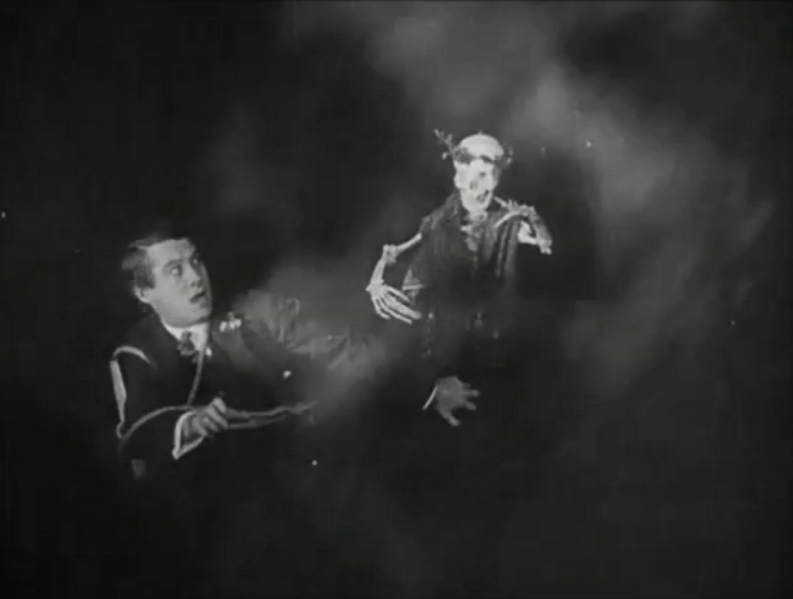
Run Time: 84 minutes. Studio: Majestic Motion Picture Company. Director: D.W. Griffith. Writer: D.W. Griffith. Based on the works of Edgar Allan Poe. Main Cast: Henry B. Walthall, Spottiswoode Aitken, Blanche Sweet, George Siegmann, Ralph Lewis, Mae Marsh. Cinematographer: G.W. Bitzer.
As strange as it may seem, The Avenging Conscience is my personal favorite of D.W. Griffith's feature films. While Birth of a Nation (1915) and Intolerance (1916) may be more celebrated and are in many ways more technically groundbreaking, this movie simply has a strange and mysterious hold on me that reminds me why I am so in love with silent movies.
Griffith had long been an admirer of Edgar Allan Poe This movie is based on the works of Edgar Allan Poe, but is not an adaption of any specific story of his. Yet there are two stories that served as a major inspiration of this film. These stories are his 1849 poem, Annabel Lee and his famous 1843 short story, The Tell Tale Heart. This movie does a great job of mixing what made Edgar Allan Poe so great and what made D.W. Griffith such a wonderful filmmaker. The film is in many ways equal parts Poe and Griffith. What also makes this film so interesting is that it is not only inspired by Poe but directly mentions him in the story. Henry B. Walthall (who was also the Little Colonel in Birth of a Nation) plays our main character who is an author that is obsessed with Poe's writings. Him and his girlfriend (Blanche Sweet (Judith in Griffith's Judith of Bethulia (1914)) never receive names in this film, but his girlfriend is referred to in an intertitle as “she whom chosen to name ‘Annabel’.” This is a Poe reference as Walthall's character has chosen to name her after the Poe character.
The Avenging Conscience has been referred to as one of the earliest feature length horror films. However to call this a horror film is a bit of a stretch. The movie is certainly quite dark, but it rarely reaches the realm of horror any more than the majority of Alfred Hitchcock's suspense movies do (this movie had a great influence on Hitch). This is more of a moody and atmospheric murder story than a horror film. The closest to horror it gets is the climatic scenes. However in these scenes the dark images we see are simply a visual representation of what is in the main character's mind. These scenes show perfectly why silent movies are still so powerful. What we see here is not simply special effects (and darn good ones), but visual storytelling that conveys every emotion just as well as any of the best talkies can and something that is just as effective over 100 years later. This is truly a testament to the great talent of the filmmakers. Though Griffith has often been given credit for creating film techniques that he simply didn't, this movie proves that he did have a true mastery over said techniques. You can also see perfectly why cameraman Billy Bitzer (a longtime collaborator with Griffith) has received nearly as much praise from film buffs as Griffith himself. He truly helped proved that cinematography was a great art and much more than simply a man holding a movie camera. Yet not all the credit goes to him for his great work here. His assistant Karl Brown remembered that much of the insert shots in these scenes were assigned to him. Brown would later become a director himself making such films as Stark Love (1927), Flames (1932), White Legion (1936) and Under the Big Top (1938).
This may not be Griffith's best movie, but it is to me one of the most effective. Every time I watch this film, I am completely captivated by what is happening on screen and I end each viewing amazed by what I just saw. Only the ending doesn't really work.
If you have any trouble reading the pages below click on them and use your touch screen to zoom in.
Griffith had visited Edgar Allan Poe before this movie with the short film, Edgar Allen Poe (1909).
Resources Used
https://silentology.wordpress.com/2020/10/22/obscure-films-the-avenging-conscience-1914/
http://www.jbkaufman.com/movie-of-the-month/avenging-conscience-1914
https://mediahistoryproject.org/
https://www.imdb.com/




No comments:
Post a Comment